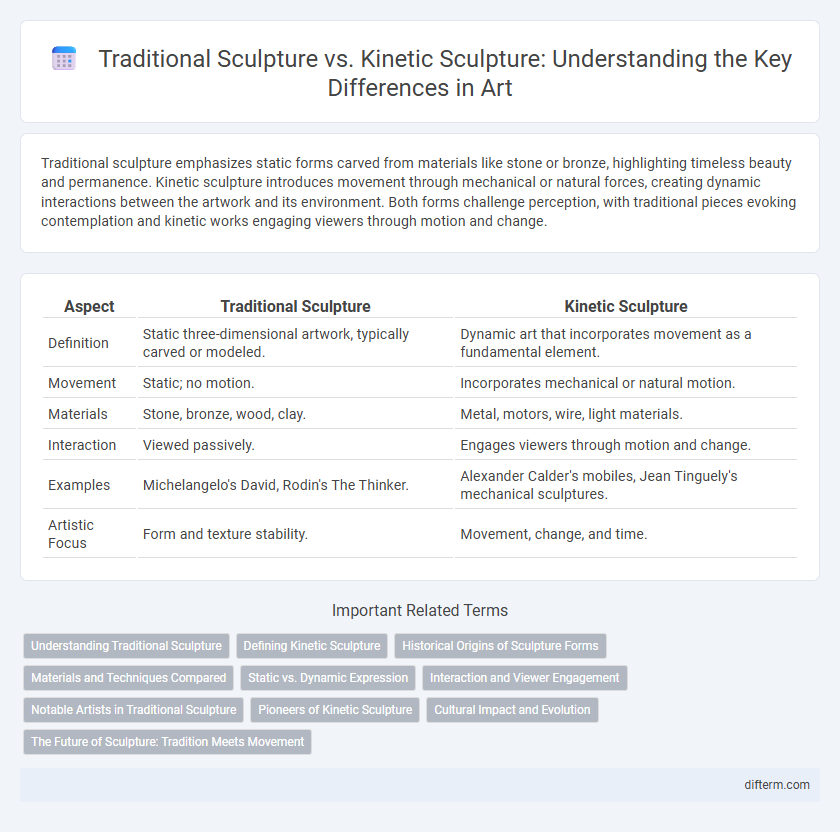Traditional sculpture emphasizes static forms carved from materials like stone or bronze, highlighting timeless beauty and permanence. Kinetic sculpture introduces movement through mechanical or natural forces, creating dynamic interactions between the artwork and its environment. Both forms challenge perception, with traditional pieces evoking contemplation and kinetic works engaging viewers through motion and change.
Table of Comparison
| Aspect | Traditional Sculpture | Kinetic Sculpture |
|---|---|---|
| Definition | Static three-dimensional artwork, typically carved or modeled. | Dynamic art that incorporates movement as a fundamental element. |
| Movement | Static; no motion. | Incorporates mechanical or natural motion. |
| Materials | Stone, bronze, wood, clay. | Metal, motors, wire, light materials. |
| Interaction | Viewed passively. | Engages viewers through motion and change. |
| Examples | Michelangelo's David, Rodin's The Thinker. | Alexander Calder's mobiles, Jean Tinguely's mechanical sculptures. |
| Artistic Focus | Form and texture stability. | Movement, change, and time. |
Understanding Traditional Sculpture
Traditional sculpture emphasizes craftsmanship through carving, modeling, or casting static materials like stone, wood, and bronze, reflecting cultural heritage and artistic conventions. It prioritizes form, texture, and anatomical accuracy to convey emotion and narrative without movement. The enduring nature of traditional sculptures allows for timeless appreciation of artistic skill and historical context.
Defining Kinetic Sculpture
Kinetic sculpture is defined as a form of art that incorporates movement as a fundamental aspect of its design, often powered by motors, wind, or human interaction. Unlike traditional sculpture, which is static and focuses on form and material permanence, kinetic sculpture engages viewers through dynamic motion and changing perspectives. This evolving nature of kinetic art challenges conventional boundaries and expands the possibilities of sculptural expression.
Historical Origins of Sculpture Forms
Traditional sculpture traces its origins to ancient civilizations such as Mesopotamia, Egypt, and Greece, where artists focused on static forms carved from stone, wood, or cast in bronze to represent religious, cultural, and historical narratives. Kinetic sculpture emerged in the 20th century, influenced by Futurism and Constructivism, emphasizing movement through mechanical parts or environmental interaction, reflecting modernity and technological advances. The historical evolution from static to dynamic forms marks a shift in artistic intent, integrating motion as a core element of sculptural expression.
Materials and Techniques Compared
Traditional sculpture predominantly employs materials such as marble, bronze, and wood, utilizing techniques like carving, casting, and chiseling to create static, enduring forms. In contrast, kinetic sculpture integrates materials including metals, plastics, and electronic components, relying on engineering principles, motors, and mechanical systems to produce movement and interactivity. The distinct material choices and craftsmanship reflect the evolution from purely tactile artistry to dynamic, multisensory experiences in contemporary sculpture.
Static vs. Dynamic Expression
Traditional sculpture emphasizes static expression by capturing a single, unchanging moment or form, often highlighting intricate details and textures frozen in time. Kinetic sculpture introduces dynamic expression through movement, incorporating mechanical or natural forces to create evolving shapes and interactive experiences. This contrast challenges viewers to engage with art either as a permanent, contemplative object or as a transient, ever-changing phenomenon.
Interaction and Viewer Engagement
Traditional sculpture offers a static experience where viewers appreciate form, texture, and craftsmanship from fixed vantage points. Kinetic sculpture incorporates movement, inviting dynamic interaction that changes the viewer's perception over time and often engages multiple senses. This active participation enhances emotional connection and transforms the artwork into an evolving dialogue between the piece and its audience.
Notable Artists in Traditional Sculpture
Notable artists in traditional sculpture include Michelangelo, renowned for his marble masterpieces like David, and Auguste Rodin, famous for expressive bronze works such as The Thinker. Gian Lorenzo Bernini's baroque sculptures showcase dynamic compositions carved from marble, while Donatello is celebrated for pioneering techniques in Renaissance sculpture. These artists emphasize solidity, permanence, and classical forms, distinguishing their work from the movement and interactivity characteristic of kinetic sculpture.
Pioneers of Kinetic Sculpture
Kinetic sculpture pioneers like Alexander Calder revolutionized traditional sculpture by incorporating movement, emphasizing dynamic interaction with space and viewers. Unlike static traditional art forms, kinetic sculptures utilize motors, wind, or human interaction to create shifting visual experiences, blurring the boundaries between sculpture and performance. The work of artists such as Jean Tinguely and Naum Gabo further advanced this field, integrating engineering and artistic innovation to challenge conventional perceptions of sculpture.
Cultural Impact and Evolution
Traditional sculpture, rooted in historical techniques and materials like marble and bronze, reflects cultural heritage and societal values through static, enduring forms. Kinetic sculpture introduces movement as a fundamental element, challenging conventional perceptions and engaging audiences in a dynamic interaction that mirrors contemporary societal shifts. The evolution from static to kinetic sculpture signifies a broader cultural transition towards interactivity and technological integration in art.
The Future of Sculpture: Tradition Meets Movement
Traditional sculpture embodies timeless craftsmanship through static forms carved from materials like marble or bronze, emphasizing permanence and physical presence. Kinetic sculpture introduces movement and interactivity, utilizing motors, wind, or human touch to create dynamic experiences that engage viewers in new ways. The future of sculpture lies in merging these approaches, combining the tactile heritage of tradition with innovative technologies to redefine artistic expression and spatial interaction.
Traditional sculpture vs kinetic sculpture Infographic

 difterm.com
difterm.com